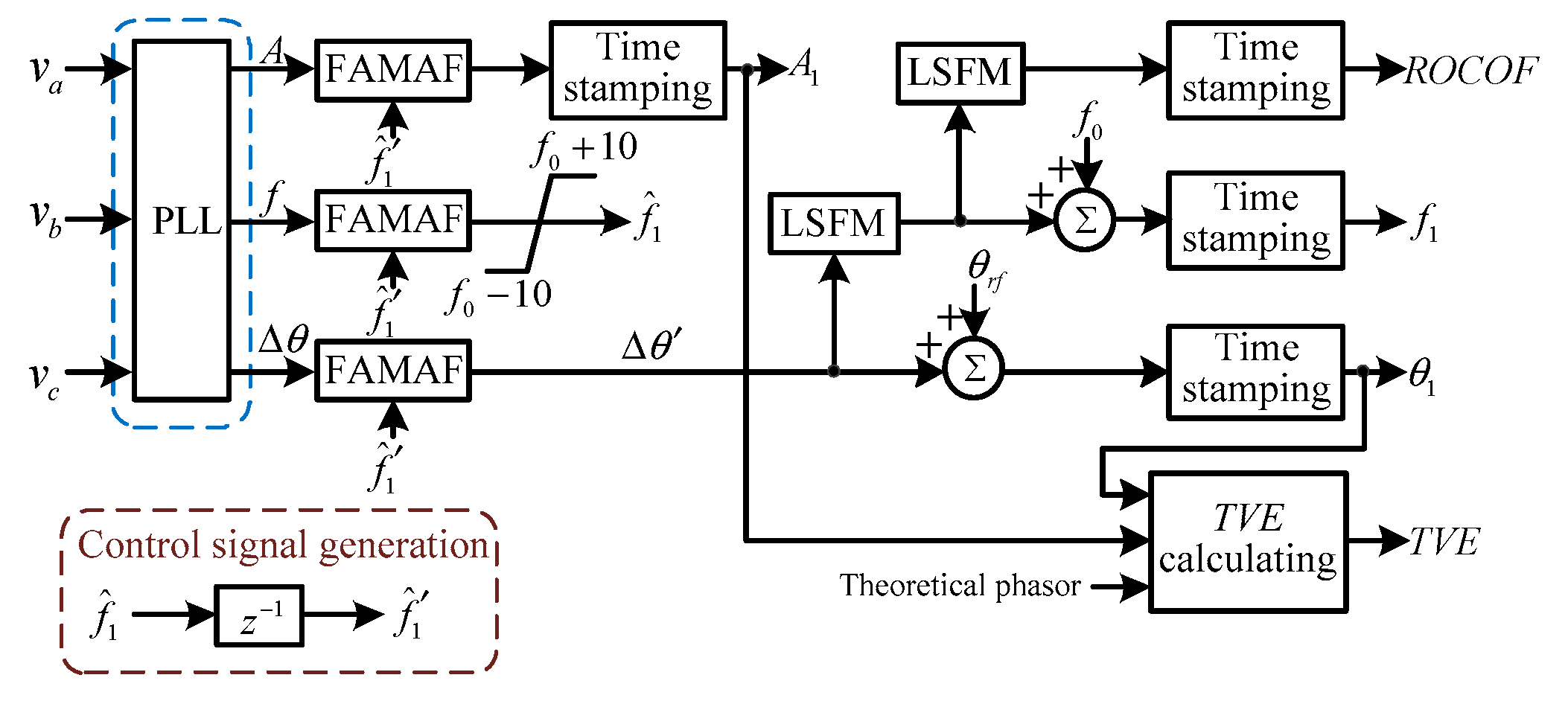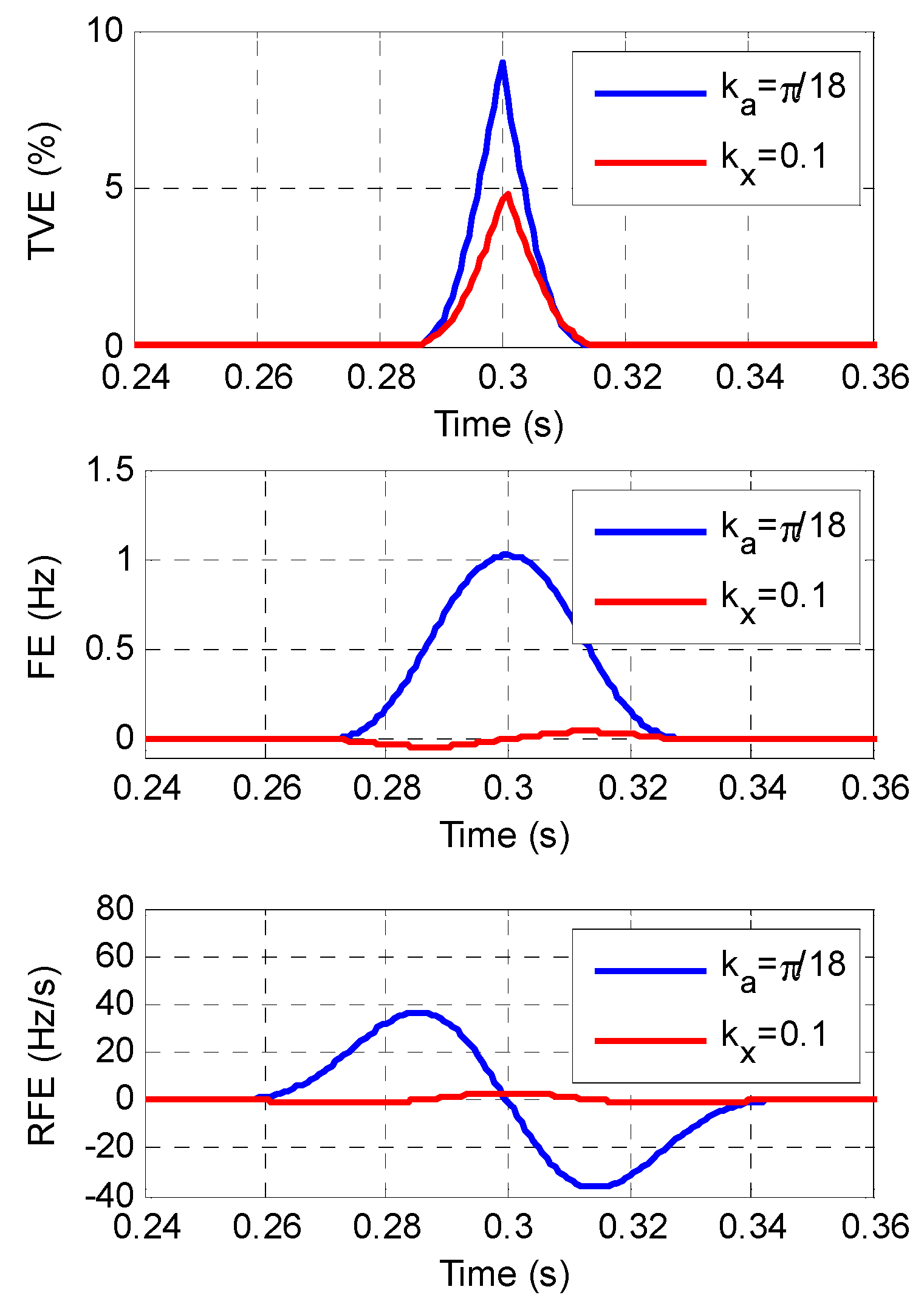A Fixed Length Adaptive Moving Average Filter-Based Synchrophasor Measurement Algorithm for P Class PMUs
Abstract
:1. Introduction
2. Materials and Methods
2.1. A Fixed Length Adaptive Moving Average Filter
2.2. The Proposed FA-PSMA
2.3. Time Stamping of the Estimated Parameters
2.4. Practical Considerations for the Digital Signal Processor(DSP) Implementation
3. Performance Assessment
3.1. Response Time Assessment
3.2. Measurement Accuracy Assessment
3.3. Comparison with the Dynamic Synchrophasor Estimation Algorithm (DPMA), the Clark Transformation-Based DFT Phasor and Frequency Algorithm (CT-DFT), and the Modified Dynamic Synchrophasor Estimationalgorithm (MDSEA)
4. Conclusions
Author Contributions
Funding
Conflicts of Interest
References
- Aminifar, F.; Fotuhi-Firuzabad, M.; Safdarian, A.; Davoudi, A.; Shahidehpour, M. Synchrophasor measurement technology in power systems: panorama and state-of-the-art. IEEE Access 2014, 2, 1607–1628. [Google Scholar] [CrossRef]
- Phadke, A.G.; Kasztenny, B. Synchronized phasor and frequency measurement under transient conditions. IEEE Trans. Power Deliv. 2009, 24, 89–95. [Google Scholar] [CrossRef]
- Hamai, K.E.M.D.; Adamiak, M.; Anderson, S.; Begovic, M.; Benmouyal, G.; Brunello, G.; Burger, J.; Cai, J.Y.; Dickerson, B.; Gharpure, V.; et al. Exploring the IEEE standard C37.118–2005 synchrophasors for power systems. IEEE Trans. Power Deliv. 2008, 23, 1805–1811. [Google Scholar]
- De la Ree, J.; Centeno, V.; Thorp, J.S.; Phadke, A.G. Synchronized phasor measurement applications in power systems. IEEE Trans. Smart Grid. 2010, 1, 20–27. [Google Scholar] [CrossRef]
- Liu, J.; Tang, J.; Ponci, F.; Monti, A.; Muscas, C.; Pegoraro, P.A. Trade-offs in PMU deployment for state estimation in active distribution grids. IEEE Trans. Smart Grid. 2012, 3, 915–924. [Google Scholar] [CrossRef]
- Borghetti, A.; Nucci, C.A.; Paolone, M.; Ciappi, G.; Solari, A. Synchronized phasors monitoring during the islanding maneuver of an active distribution network. IEEE Trans. Smart Grid. 2011, 2, 82–91. [Google Scholar] [CrossRef]
- IEC/IEEE 60255-118-1. IEEE/IEC International Standard—Measuring Relays and Protection Equipment—Part 118-1: Synchrophasor for Power Systems—Measurements; IEEE: Piscataway, NJ, USA, 2018. [Google Scholar]
- Kamwa, I.; Samantaray, S.R.; Joos, G. Wide frequency range adaptive phasor and frequency PMU algorithms. IEEE Trans. Smart Grid. 2014, 5, 569–579. [Google Scholar] [CrossRef]
- Belega, D.; Macii, D.; Petri, D. Fast synchrophasor estimation by means of frequency-domain and time-domain algorithms. IEEE Trans. Instrum. Meas. 2014, 63, 388–401. [Google Scholar] [CrossRef]
- De la O Serna, J.A.; Martin, K.E. Improving phasor measurements under power system oscillations. IEEE Trans. Power Syst. 2003, 18, 160–166. [Google Scholar] [CrossRef]
- Karimi-Ghartemani, M.; Ooi, B.; Bakhshai, A. Application of enhanced phase-locked loop system to the computation of synchrophasors. IEEE Trans. Power Deliv. 2011, 26, 22–32. [Google Scholar] [CrossRef]
- Romano, P.; Paolone, M. Enhanced interpolated-dft for synchrophasor estimation in fpgas: Theory, implementation and validation of a PMU prototype. IEEE Trans. Instrum. Meas. 2014, 63, 2824–2836. [Google Scholar] [CrossRef]
- Xia, T.; Liu, Y. Single-phase phase angle measurement in electric power systems. IEEE Trans. Power Syst. 2010, 24, 844–852. [Google Scholar] [CrossRef]
- Zeng, B.; Teng, Z.; Cai, Y.; Guo, S.; Qing, B. Harmonic phasor analysis based on improved FFT algorithm. IEEE Trans. Smart Grid. 2011, 2, 51–59. [Google Scholar] [CrossRef]
- Macii, D.; Petri, D.; Zorat, A. Accuracy analysis and enhancement of DFT-based synchrophasor estimators in off-nominal conditions. IEEE Trans. Instrum. Meas. 2012, 61, 2653–2664. [Google Scholar] [CrossRef]
- Zhan, L.; Liu, Y.; Liu, Y. A clarke transformation-based DFT phasor and frequency algorithm for wide frequency range. IEEE Trans. Smart Grid. 2018, 9, 67–77. [Google Scholar] [CrossRef]
- Zhan, L.; Liu, Y.; Culliss, J.; Zhao, J.; Liu, Y. Dynamic single-phase synchronized phase and frequency estimation at the distribution level. IEEE Trans. Smart Grid. 2015, 6, 2013–2022. [Google Scholar] [CrossRef]
- Nguyen, C.T.; Srinivasan, K. A new technique for rapid tracking of frequency deviations based on level crossings. IEEE Trans. Power Appar. Syst. 1984, PAS-103, 2230–2236. [Google Scholar] [CrossRef]
- Wood, H.C.; Johnson, N.G.; Sachdev, M.S. Kalman filtering applied to power system measurements relaying. IEEE Trans. Power Appar. Syst. 1985, PAS-104, 3565–3573. [Google Scholar] [CrossRef]
- Chen, C.I.; Chang, G.W.; Hong, R.C.; Li, H.M. Extended real model of Kalman filter for time-varying harmonics estimation. IEEE Trans. Power Deliv. 2010, 25, 17–26. [Google Scholar] [CrossRef]
- Terzija, V.V.; Djuric, M.B.; Kovacevic, B.D. Voltage phasor and local system frequency estimation using Newton type algorithm. IEEE Trans. Power Deliv. 1994, 9, 1368–1374. [Google Scholar] [CrossRef]
- Dash, P.K.; Panda, S.K.; Mishra, B.; Swain, D.P. Fast estimation of voltage and current phasors in power networks using an adaptive neural network. IEEE Trans. Power Syst. 1997, 12, 1494–1499. [Google Scholar] [CrossRef]
- Kamwa, I.; Grondin, R. Fast adaptive schemes for tracking voltage phasor and local frequency in power transmission and distribution systems. IEEE Trans. Power Deliv. 1992, 7, 789–795. [Google Scholar] [CrossRef]
- Sadinezhad, I.; Agelidis, V.G. Real-time power system phasors and harmonics estimation using a new decoupled recursive-least-squares technique for DSP implementation. IEEE Trans. Ind. Electron 2013, 60, 2295–2308. [Google Scholar] [CrossRef]
- Vejdan, S.; Sanaye-Pasand, M.; Malik, O.P. Accurate dynamic phasor estimation based on the signal model under off-nominal frequency and oscillations. IEEE Trans. Smart Grid. 2017, 8, 708–719. [Google Scholar] [CrossRef]
- Ren, J.; Kezunovic, M. Real-time power system frequency and phasors estimation using recursive wavelet transform. IEEE Trans. Power Deliv. 2011, 26, 1392–1402. [Google Scholar] [CrossRef]
- Chauhan, K.; Reddy, M.V.; Sodhi, R. A novel distribution-level phasor estimation algorithm using empirical wavelet transform. IEEE Trans. Ind. Electron 2018, 65, 7984–7995. [Google Scholar] [CrossRef]
- Fu, L.; Zhang, J.; Xiong, S.; He, Z.; Mai, R. A modified dynamic synchrophasor estimation algorithm considering frequency deviation. IEEE Trans. Smart Grid. 2017, 8, 640–650. [Google Scholar] [CrossRef]
- Mai, R.K.; He, Z.Y.; Fu, L.; Kirby, B.; Bo, Z.Q. A dynamic synchrophasor estimation algorithm for online application. IEEE Trans. Power Deliv. 2010, 25, 570–578. [Google Scholar] [CrossRef]
- Banerjee, P.; Srivastava, S.C. A subspace-based dynamic phasor estimator for synchrophasor application. IEEE Trans. Instrum. Meas. 2012, 61, 2436–2445. [Google Scholar] [CrossRef]
- Hui, N.; Wang, D.; Li, Y. A novel hybrid filter-based PLL to eliminate effect of input harmonics and DC offset. IEEE Access 2018, 6, 19762–19773. [Google Scholar] [CrossRef]
- Freijedo, F.D.; Doval-Gandoy, J.; LÓpez, Ó.; Acha, E. A generic open-loop algorithm for three-phase grid voltage/current synchronization with particular reference to phase, frequency, and amplitude estimation. IEEE Trans. Power Electron 2009, 24, 94–107. [Google Scholar] [CrossRef]
- Wang, L.; Jiang, Q.; Long, L.; Zhang, C.; Wei, Y. A novel phase-locked loop based on frequency detector and initial phase angle detector. IEEE Trans. Power Electron 2013, 28, 4538–4549. [Google Scholar] [CrossRef]
- Golestan, S.; Freijedo, F.D.; Vidal, A.; Guerrero, J.M.; Doval-Gandoy, J. A quasi-type-1 phase-locked loop structure. IEEE Trans. Power Electron 2014, 29, 6264–6270. [Google Scholar] [CrossRef]
- Kanjiya, P.; Khadkikar, V.; Moursi, M.S.E. A novel type-1 frequency-locked loop for fast detection of frequency and phase with improved stability margins. IEEE Trans. Power Electron 2016, 31, 2550–2561. [Google Scholar] [CrossRef]
- Li, Y.; Wang, D.; Han, W.; Tan, S.; Guo, X. Performance improvement of quasi-type-1 PLL by using a complex notch filter. IEEE Access 2016, 4, 6272–6282. [Google Scholar] [CrossRef]





| Process | Real Multiplication | Real Addition |
|---|---|---|
| Clark’s Transformation | 6 | 4 |
| Park’s Transformation | 4 | 2 |
| FAMAF | 3 | 4 |
| r | 2 | 2 |
| PLL | 6 | 2 |
| LSFM | 10 | 8 |
| Parameter | TVE Rsp. (ms) | FE Rsp. (ms) | RFE Rsp. (ms) |
|---|---|---|---|
| 14 | 55 | 92 | |
| 12 | 52 | 90 | |
| Std.Req. | 40 | 90 | 120 |
| Case | Methods | TVE (%) | FE (Hz) | RFE (Hz/s) | PE (degree) | ME (pu) |
|---|---|---|---|---|---|---|
| 1 | IEEE Std. | 1 | 5e-3 | 0.4 | N/A | N/A |
| FA-PSMA | 2e-4 | 1e-7 | 1e-6 | 1e-4 | 1e-7 | |
| 2 | IEEE Std. | 1 | 5e-3 | 0.4 | N/A | N/A |
| FA-PSMA | 5e-4 | 5e-12 | 7e-11 | 3e-11 | 5e-6 | |
| 3 | IEEE Std. | 1 | 0.01 | 0.4 | N/A | N/A |
| FA-PSMA | 1e-2 | 1e-6 | 1e-5 | 1e-2 | 5e-6 | |
| 4 | IEEE Std. | 3 | 0.06 | 2.3 | N/A | N/A |
| FA-PSMA | 0.2 | 0.03 | 1.5 | 0.1 | 1e-5 | |
| 5 | IEEE Std. | 3 | 0.06 | 2.3 | N/A | N/A |
| FA-PSMA | 0.2 | 1e-4 | 1e-5 | 4e-4 | 2e-3 | |
| 6 | IEEE Std. | 1 | 5e-3 | 0.4 | N/A | N/A |
| FA-PSMA | 6e-4 | 2e-6 | 4e-5 | 1e-4 | 5e-6 | |
| 7 | IEEE Std. | 1 | 0.01 | 0.4 | N/A | N/A |
| FA-PSMA | 1e-2 | 4e-6 | 7e-5 | 1e-2 | 8e-6 | |
| 8 | IEEE Std. | 3 | 0.06 | 2.3 | N/A | N/A |
| FA-PSMA | 0.18 | 0.026 | 1.3 | 0.1 | 1e-4 | |
| 9 | IEEE Std. | 3 | 0.06 | 2.3 | N/A | N/A |
| FA-PSMA | 0.26 | 0.026 | 1.3 | 0.1 | 1.8e-3 |
| Frequency | Methods | FE (Hz) | RFE (Hz/s) | TVE (%) | |
|---|---|---|---|---|---|
| Case 1 | 45 Hz | DPMA | 2.05 | 11.37 | 10.02 |
| CT-DFT | 4.5e-3 | 0.57 | 1.46 | ||
| MDSEA | 8.4e-3 | 0.77 | 0.73 | ||
| FA-PSMA | 7e-3 | 0.23 | 0.30 | ||
| 47.5 Hz | DPMA | 0.47 | 1.56 | 1.97 | |
| CT-DFT | 3e-3 | 0.46 | 1.44 | ||
| MDSEA | 0.055 | 0.64 | 0.78 | ||
| FA-PSMA | 4e-3 | 0.12 | 0.27 | ||
| 50 Hz | DPMA | 3e-3 | 0.56 | 0.70 | |
| CT-DFT | 1.7e-3 | 0.39 | 1.41 | ||
| MDSEA | 3e-3 | 0.56 | 0.70 | ||
| FA-PSMA | 2e-5 | 1e-4 | 0.26 | ||
| Case 2 | 45 Hz | DPMA | 2.24 | 14.47 | 11.12 |
| CT-DFT | 0.11 | 3.40 | 1.35 | ||
| MDSEA | 0.21 | 4.74 | 0.66 | ||
| FA-PSMA | 0.04 | 1.86 | 0.29 | ||
| 47.5 Hz | DPMA | 0.54 | 4.71 | 2.29 | |
| CT-DFT | 0.11 | 3.31 | 1.33 | ||
| MDSEA | 0.20 | 4.65 | 0.72 | ||
| FA-PSMA | 0.04 | 1.84 | 0.27 | ||
| 50 Hz | DPMA | 0.20 | 4.63 | 0.65 | |
| CT-DFT | 0.10 | 3.23 | 1.30 | ||
| MDSEA | 0.20 | 4.64 | 0.65 | ||
| FA-PSMA | 0.04 | 1.82 | 0.25 |
© 2019 by the authors. Licensee MDPI, Basel, Switzerland. This article is an open access article distributed under the terms and conditions of the Creative Commons Attribution (CC BY) license (http://creativecommons.org/licenses/by/4.0/).
Share and Cite
Xue, H.; Ruan, M.; Cheng, Y. A Fixed Length Adaptive Moving Average Filter-Based Synchrophasor Measurement Algorithm for P Class PMUs. Energies 2019, 12, 4168. https://doi.org/10.3390/en12214168
Xue H, Ruan M, Cheng Y. A Fixed Length Adaptive Moving Average Filter-Based Synchrophasor Measurement Algorithm for P Class PMUs. Energies. 2019; 12(21):4168. https://doi.org/10.3390/en12214168
Chicago/Turabian StyleXue, Hui, Mengjie Ruan, and Yifan Cheng. 2019. "A Fixed Length Adaptive Moving Average Filter-Based Synchrophasor Measurement Algorithm for P Class PMUs" Energies 12, no. 21: 4168. https://doi.org/10.3390/en12214168
APA StyleXue, H., Ruan, M., & Cheng, Y. (2019). A Fixed Length Adaptive Moving Average Filter-Based Synchrophasor Measurement Algorithm for P Class PMUs. Energies, 12(21), 4168. https://doi.org/10.3390/en12214168




